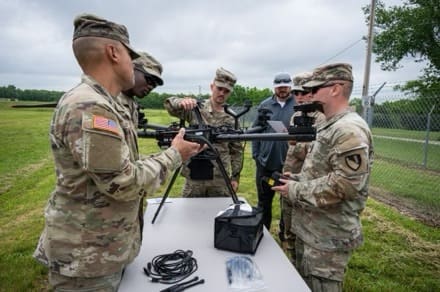FORT LEONARD WOOD, Mo. — The Army Futures Command Maneuver Support Battle Lab is winding down this year’s Maneuver Support and Protection Integration eXperiments event, commonly referred to as MSPIX, after assessing 16 emerging technologies from May 6 to 23, 2024, at locations across Fort Leonard Wood.

According to Kyle Henry, MSBL Experimentation Branch chief and one of the key organizers of the event, MSPIX puts the latest tools in the hands of Soldiers while also giving capability developers and the science and technology community credible and validated operational experiment venues for their conceptual and materiel development.
Soldiers from Fort Leonard Wood; Fort Bliss, Texas; and Fort Riley, Kansas took part in the assessments.
“Soldier touchpoints early in the capability design process are key to influencing the end product and its ability to support the end user, U.S. Army Soldiers. Key stakeholders are invited to observe the assessment, including the (Maneuver Support Center of Excellence) regiments and members of the (protection warfighting function) community,” Henry said.
Jarret Ellis, an MSBL engineer, said it is crucial to get Soldiers involved in the development of technologies early on to make sure new equipment being issued meets their current needs.
“When these private industry companies come out with technology they think will be helpful, the Soldiers can point them in the right direction,” Ellis said. “A lot of times, the people developing the equipment are not Soldiers in the field — they are from academia, engineers and scientists. MSPIX brings the groups together.”
Soldiers from Army Engineer; Military Police; and Chemical, Biological, Radiological and Nuclear backgrounds participated in this year’s assessments, Henry said.
On May 15, Soldiers from the 16th Brigade Engineer Battalion at Fort Bliss and the 50th Multi-Role Bridge Company, based on Fort Leonard Wood, were at training area 224 to get their hands on a drone programmed to find subsurface explosives in real time by performing aerial surveillance.
The Soldiers were handed instructions on how to setup the Airborne Ground Mines Detection System, calibrate the software and prepare the unmanned aircraft system to sweep a designated area. After the Soldiers performed the steps, the drone took flight over the training area while sending data back to a computer the Soldiers were monitoring.
“Today we are assessing a means to detect explosive hazards. We are working on detecting threats that are buried or partially buried that could kill Soldiers and destroy equipment,” Ellis said. “This is one of the first looks we have had at something that is UAS-borne that could potentially detect hazards without putting Soldiers into the threat.”
Henry said the AGMDS was one of the technologies he was personally most excited to see in action this year. The others were the robotics for engineering operations and chemical, biological, radiological and nuclear sensors in robotic platforms.
“The REO provides standoff and autonomous terrain shaping. The CSIRP is an unmanned and autonomous area reconnaissance that relays information to mission commanders,” Henry explained.
Next year’s MSPIX focus areas will include, according to Henry, wet-gap crossing, situational understanding and protection decision support, obscuration and camouflage and toxic industrial materials site assessment.
By Melissa Buckley, Fort Leonard Wood Public Affairs Office

